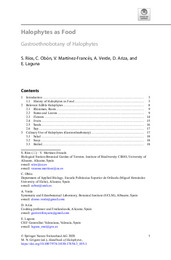Título :
Gastroethnobotany of Halophytes |
Autor :
Ríos, Segundo
Obon, Concepcion 
MARTINEZ-FRANCES, VANESSA 
Verde, A.
Ariza, D.
Laguna, E. |
Editor :
Springer Link |
Departamento:
Departamentos de la UMH::Biología Aplicada |
Fecha de publicación:
2020 |
URI :
https://hdl.handle.net/11000/31008 |
Resumen :
The halophytes are a specialized group of plants among which there are some
representatives that have been cultivated for millenia. Domesticated or wild
lineages are also consumed as food, being chard and dates fruits a good example
of it. Other species highly appreciated and consumed locally are collected from
wild, like Crithmum, and form part of the traditional cuisine of various areas of
the planet. Within this group, some are the object of global cultivation and are
distributed by haute cuisine networks such as Salicornia, Mertensia, or Tetragonia.
Finally, there are other wild halophytes that were only consumed in
situations of extreme need such as famines. Generally, they have not been
appreciated by the populations that collect them, such as Halosarcia, Suaeda,
or Arthrocnemum. The case of Tetragonia, a species native to Australia, is very
significant. The perception of the aborigines, who did not eat it, was different
from that of the European settlers who did consume them and even sent their
seeds to Europe for domestication and cultivation as new vegetable. Currently,
the new gastronomy, sometimes based on tradition and others on experimentation
itself, has incorporated into the kitchen many news halophytes and with them has
developed numerous unpublished and novel recipes.
|
Palabras clave/Materias:
Ethnobiology
Edible halophytes
Modern gastronomy
Wild food plants
Famine die |
Área de conocimiento :
CDU: Ciencias puras y naturales: Biología: Biología general y teórica |
Tipo de documento :
info:eu-repo/semantics/article |
Derechos de acceso:
info:eu-repo/semantics/openAccess
Attribution-NonCommercial-NoDerivatives 4.0 Internacional |
DOI :
https://doi.org/10.1007/978-3-030-57635-6 |
Aparece en las colecciones:
Libros /Capítulos de Libros- Biología Aplicada
|
 La licencia se describe como: Atribución-NonComercial-NoDerivada 4.0 Internacional.
La licencia se describe como: Atribución-NonComercial-NoDerivada 4.0 Internacional.
.png)
